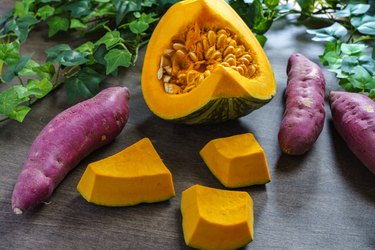
Squash and sweet potatoes are convenient, colorful vegetables that make healthy additions to any dish. Although they may not be traditional staples, they're rich in history, nutrition and taste. Consider them an option to add wholesome variety at meal time.
History
Video of the Day
Sweet potatoes and squash originated in the Americas. According to the U.S. Department of Agriculture, sweet potatoes came from the warm climates of Central and South America where they were staples of Aztec and Incan diets. They were introduced to Europe by Christopher Columbus and to Asia by subsequent explorers.
Video of the Day
Squash originated in North America where it was domesticated by Native Americans and also eaten by European settlers. The colonists gave squash its name, derived from a Native American word for "something eaten raw."
Selection
Squash comes in varieties that are specific to the season in which they're harvested:
- Yellow squash and zucchini are available in the warmer months when their skin is still tender.
- Butternut and acorn squash are produced in colder months.
- Summer squashes should be slightly tender and glossy, without blemishes.
- Winter squashes should be firm, heavy and have a tough rind.
Sweet potatoes are harvested in the fall. Fresh sweet potatoes are smooth, uniform and firm. Avoid any sweet potato with damage to the skin since the flesh is susceptible to contamination.
Nutritional Information
Both squash and sweet potatoes are low in fat, cholesterol and sodium, making them excellent choices for a balanced diet. They are rich in micronutrients, especially vitamin A, vitamin C, vitamin B6, potassium and manganese.
Sweet potatoes are a good source of dietary fiber, and squash provides an additional boost with vitamin E and calcium. Neither vegetable has a negative impact on weight or health maintenance in its natural state.
Preparation
Squash preparation depends on the variety. Summer squash is immature with edible skin, making it a candidate for most methods, including boiling, steaming, sautéing and baking. It can be sliced or divided as desired to fit the dish. Winter squash is usually baked and then cut open to extract the pulpy flesh from the rind.
Sweet potatoes are traditionally baked in their skin, although they can be peeled and cubed for casseroles or boiled and mashed like white potatoes. The naturally sweet flavor can be enhanced with brown sugar and cinnamon.